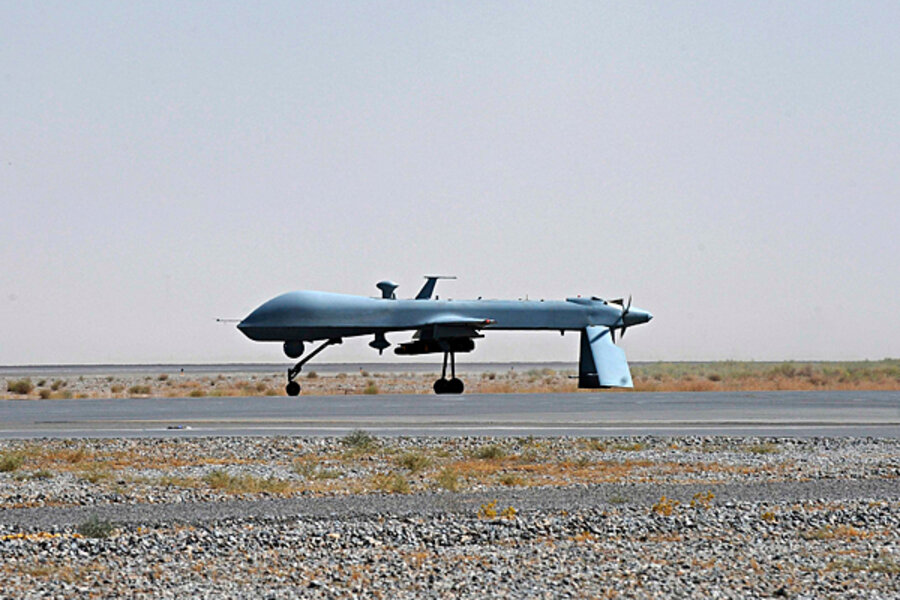Did Iran just down a US drone by 'spoofing'?
Loading...
• A daily summary of global reports on security issues.
Iran claims it captured a United States drone in its airspace over the Persian Gulf, and though the US denies the downing of one of its intelligence-gathering drones, the claim highlights the role unmanned surveillance aircraft have played in the tense clandestine conflict between the US and Iran.
The crux of the tension between Iran and the US, as well as a number of European nations and Israel, is Iran’s suspected development of nuclear weapons [See our recent cover story on why Iran's ayatollah distrusts the US and what that means for nuclear talks and the possibility of war with the West]. Iran claims its nuclear goals are focused on civilian nuclear power, but the tensions around its nuclear program are palpable, and have inspired something of a “covert war” between Iran and the West. The Christian Science Monitor reported last year that “[t]he war has already seen assassinations of Iranian nuclear scientists, mysterious explosions at Iran’s missile and industrial facilities, and the Stuxnet virus that set back Iran’s nuclear program,” in addition to the targeting of US surveillance drones.
Iranian state television today showed images of a Boeing ScanEagle drone in front of a map of the Persian Gulf, according to the New York Times. In Persian and English the map read “We will trample the U.S. under our feet,” next to an Iranian coat of arms. The Associated Press reports that if Iran’s claims are true, this "would be the third reported incident involving Iran and U.S. drones in the past two years."
Rear Adm. Ali Fadavi, the commander of the Revolutionary Guards Corps naval forces, said that after the drone violated Iranian airspace, his forces “hunted” it down and “forced it to land electronically,” reports the NY Times.
US denies
A spokesman for the US Naval Forces Central Command in Bahrain told Reuters that "The U.S. Navy has fully accounted for all unmanned air vehicles (UAV) operating in the Middle East region. Our operations in the Gulf are confined to internationally recognized water and air space."
The commander added, "We have no record that we have lost any ScanEagles recently."
Though the US denies Iran’s downing of a drone today, last December “Iran gained possession of a US stealth drone spying on a nuclear site. An Iranian engineer told the Monitor that Iran had hijacked the drone by manipulating its global positioning system coordinates, making it land in Iran,” according to The Monitor’s Scott Peterson. The NY Times notes that the US contends the RQ-170 drone crashed in Iranian territory last year.
Mr. Peterson, who broke the story on Iran’s success bringing down last year’s Stealth drone, says that if Iran’s claims today are true, it likely used the same electronic tactics as last time. In December 2011, Peterson described the technique, known as "spoofing":
Using knowledge gleaned from previous downed American drones and a technique proudly claimed by Iranian commanders in September, the Iranian specialists then reconfigured the drone's GPS coordinates to make it land in Iran at what the drone thought was its actual home base in Afghanistan.
"The GPS navigation is the weakest point," the Iranian engineer told the Monitor, giving the most detailed description yet published of Iran's "electronic ambush" of the highly classified US drone. "By putting noise [jamming] on the communications, you force the bird into autopilot. This is where the bird loses its brain."
The “spoofing” technique that the Iranians used – which took into account precise landing altitudes, as well as latitudinal and longitudinal data – made the drone “land on its own where we wanted it to, without having to crack the remote-control signals and communications” from the US control center, says the engineer.
Iran has exaggerated its capabilities in the past, Peterson notes. "But experts say that there is also a history of the US underestimating Iran’s electronic warfare and cyber expertise,” he wrote in a separate Monitor story after Iran claimed to have unlocked data from the drone last year.
"The problem with Iran is they cry wolf a lot, and we never know what to believe, and people get desensitized to real information," says Tyler Rogoway, who publishes the AviationIntel.com website from Portland, Ore.
"But when you have a fairly serious commander that runs their aerospace division, and he goes into these specific details – not these large, overreaching triumphant [declarations] – he's talking about real things ... that's a message to the [US] government, 'Hey, we caught you.’"
Last month Iran complained to the United Nations of eight violations of its airspace by US planes, and on Nov. 8 the Pentagon reported the first known instance of a warplane firing on a US drone after Iran shot at a Predator drone flying over the Gulf two weeks prior.
Other nations use same model
AP reports that Navy Spokesman Cmdr. Jason Salata said operations in the Persian Gulf are "confined to internationally recognized water and airspace," casting doubt on Iranian claims.
Salata also noted that other nations in the area, including the United Arab Emirates, use the same model of ScanEagle drones.
The US has been using “stealth drones” since the 1990s and in combat for the past decade, according to Foreign Policy. The online version of the policy magazine reported yesterday that France recently joined the US as “the second nation in the world to (publicly) fly a stealth [Unmanned Aerial Vehicle].” Though other countries may not be far behind.
The U.S. and France aren't the only countries making stealth drones. U.K.-based BAE Systems is hard at work producing the Taranis, while Russia's MiG is trying to field a stealth UAV called the Skat, seriously. Meanwhile, you can bet China will unveil a stealth UAV in the near future.
Want to know more? Read 'Inside the mind of Iran's Khamenei!'








